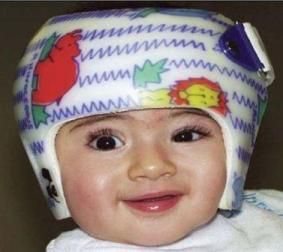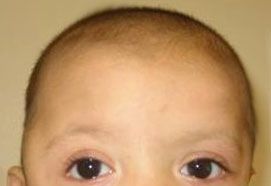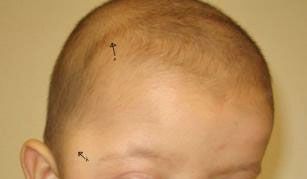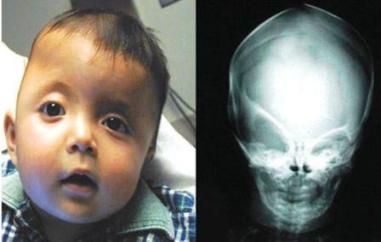Positional Plagiocephaly and Craniosynostosis: A Photo Essay of Misshapen Heads
Craniosynostosis is a condition in which one or more of the fibrous sutures in an infant skull prematurely fuses by ossification, thereby changing the growth pattern of the skull.
Positional plagiocephaly may be the result of uterine "crowding" or chronic supine positioning during sleep while the infant's skull is still malleable. The resulting deformity is often unilateral occipital flattening (seen here) with ipsilateral anterior displacement of the craniofacial features.

Photo courtesy of Peter J. Taub, MD and Paul Pierce, MD
An orthotic cranial molding helmet offers effective treatment of infants with nonsynostotic positional plagiocephaly.

Photo courtesy of Peter J. Taub, MD and Paul Pierce, MD
Strabismus (also seen in the previous Figure) can be a sign of craniosynostosis and should prompt additional assessment. The 2-month old child in this Figure had asymmetric coronal craniosynostosiswith a small external hydrocephalus (visible on next slide).

Photo courtesy of Muhammad Moin Uddin, MD and Rahima Afroza, MD
Characteristic signs of asymmetric coronal craniosynostosis are evident here. Visible bulging at the temporal area of the child's head (bottom arrow, and slightly visible in the previous Figure) and a ridge along the right coronal suture area (top arrow). Asymmetric facial growth is also visible; the right side had grown faster than the left. (Note: between the 2-month and 4-month well-child visits, the child's head circumference had fallen from the 68th to the 50th percentile.)

Photo courtesy of Muhammad Moin Uddin, MD and Rahima Afroza, MD
Anterior plagiocephaly, a subtype of craniosynostosis, involves the coronal suture. Unilateral cornonal synostosis produces a characteristic asymmetrical drawn-up or windblown appearance to the orbit on the side of the fusion (Left). The plain anteroposterior radiograph (Right) shows a characteristic "harlequin" deformity-the result of the different orbital shapes.

Photo courtesy of Peter J. Taub, MD and Paul Pierce, MD
Click here to return to the beginning